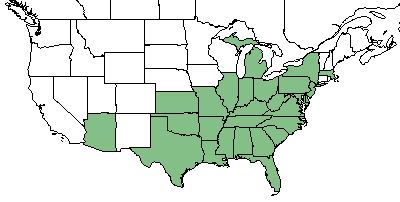Difference between revisions of "Juncus biflorus"
| Line 31: | Line 31: | ||
==Ecology== | ==Ecology== | ||
===Habitat=== <!--Natural communities, human disturbed habitats, topography, hydrology, soils, light, fire regime requirements for removal of competition, etc.--> | ===Habitat=== <!--Natural communities, human disturbed habitats, topography, hydrology, soils, light, fire regime requirements for removal of competition, etc.--> | ||
| − | The main communities ''J. biflorus'' can be found include pine savannahs, pine flatwoods, mesic portions of sandhill-pocosin ecotones, and even roadsides, wet meadows, interdune swales, tidal marshes, and ditches. <ref name= "Weakley"> Weakley, A. S. (2015). Flora of the Southern and Mid-Atlantic States. Chapel Hill, NC, University of North Carolina Herbarium. </ref> As well, ''J. biflorus'' has been observed on the margin of an old wet fireland, margin of wet woods, and in a flooded depression. <ref name | + | The main communities ''J. biflorus'' can be found include pine savannahs, pine flatwoods, mesic portions of sandhill-pocosin ecotones, and even roadsides, wet meadows, interdune swales, tidal marshes, and ditches. <ref name= "Weakley"> Weakley, A. S. (2015). Flora of the Southern and Mid-Atlantic States. Chapel Hill, NC, University of North Carolina Herbarium. </ref> As well, ''J. biflorus'' has been observed on the margin of an old wet fireland, margin of wet woods, and in a flooded depression. <ref name= "Herbarium"> Florida State University Robert K. Godfrey Herbarium database. URL: http://herbarium.bio.fsu.edu. Last accessed: June 2018. Collectors: John B. Nelson, Wade Biltoft, Keith Bradley, Daniel Castillo, and Richard D. Porcher. States and counties: South Carolina: Berkely and Orangeburg. </ref> |
===Phenology=== <!--Timing off flowering, fruiting, seed dispersal, and environmental triggers. Cite PanFlora website if appropriate: http://www.gilnelson.com/PanFlora/ --> | ===Phenology=== <!--Timing off flowering, fruiting, seed dispersal, and environmental triggers. Cite PanFlora website if appropriate: http://www.gilnelson.com/PanFlora/ --> | ||
Revision as of 19:46, 14 June 2018
| Juncus biflorus | |
|---|---|
Error creating thumbnail: Unable to save thumbnail to destination
| |
| Photo by Gary Fleming at the Digital Atlas of the Virginia Flora | |
| Scientific classification | |
| Kingdom: | Plantae |
| Division: | Magnoliophyta - Flowering plants |
| Class: | Liliopsida - Moncots |
| Order: | Juncales |
| Family: | Juncaceae |
| Genus: | Juncus |
| Species: | J. biflorus |
| Binomial name | |
| Juncus biflorus Ell. | |

| |
| Natural range of Juncus biflorus from USDA NRCS Plants Database. | |
Contents
Taxonomic Notes
Synonyms: Juncus marginatus Rostkovius, and Juncus aristulatus Michaux var. biflorus (Elliott) Small
Varieties: none
Description
Also known as bog rush, J. biflorus is a native perennial graminoid that is a member of the Juncaceae family. It has a rapid rhizomatous growth form reaching a mature height of 3.5 feet. [1]
Distribution
J. biflorus can be found in the Southeastern United States from Mississippi and up to Michigan as well as along the Atlantic coast to New Jersey. [1]
Ecology
Habitat
The main communities J. biflorus can be found include pine savannahs, pine flatwoods, mesic portions of sandhill-pocosin ecotones, and even roadsides, wet meadows, interdune swales, tidal marshes, and ditches. [2] As well, J. biflorus has been observed on the margin of an old wet fireland, margin of wet woods, and in a flooded depression. [3]
Phenology
Fruit development has been observed in May and August. [3]
Conservation and Management
J. biflorus is listed as endangered in the state of New York, and is listed as threatened in the state of Pennsylvania. [1]
Cultivation and restoration
Photo Gallery
References and notes
- ↑ 1.0 1.1 1.2 USDA Plants Database URL: https://plants.usda.gov/core/profile?symbol=JUBI
- ↑ Weakley, A. S. (2015). Flora of the Southern and Mid-Atlantic States. Chapel Hill, NC, University of North Carolina Herbarium.
- ↑ 3.0 3.1 Florida State University Robert K. Godfrey Herbarium database. URL: http://herbarium.bio.fsu.edu. Last accessed: June 2018. Collectors: John B. Nelson, Wade Biltoft, Keith Bradley, Daniel Castillo, and Richard D. Porcher. States and counties: South Carolina: Berkely and Orangeburg.